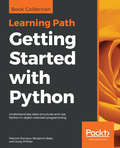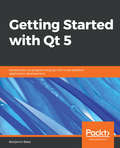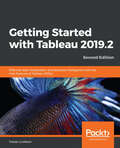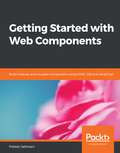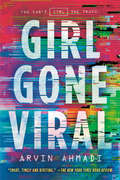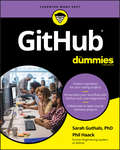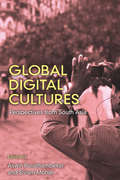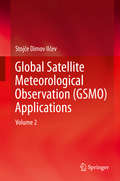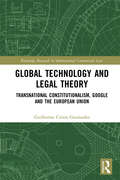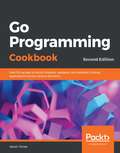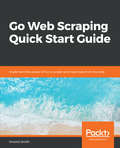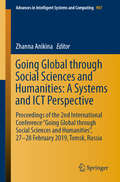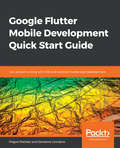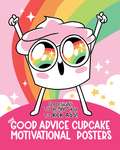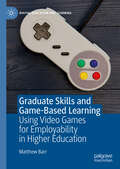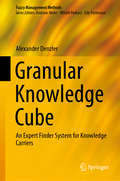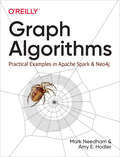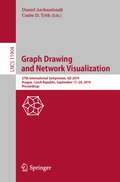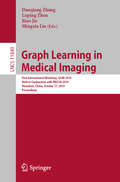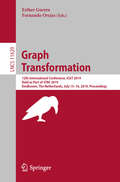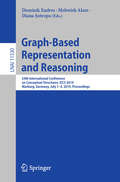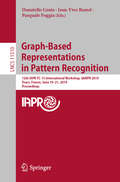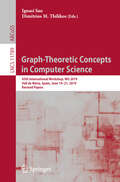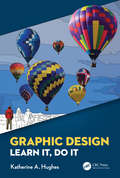- Table View
- List View
Getting Started with Python: Understand key data structures and use Python in object-oriented programming
by Dusty Phillips Fabrizio Romano Benjamin BakaHarness the power of Python objects and data structures to implement algorithms for analyzing your data and efficiently extracting informationKey FeaturesTurn your designs into working software by learning the Python syntaxWrite robust code with a solid understanding of Python data structuresUnderstand when to use the functional or the OOP approachBook DescriptionThis Learning Path helps you get comfortable with the world of Python. It starts with a thorough and practical introduction to Python. You’ll quickly start writing programs, building websites, and working with data by harnessing Python's renowned data science libraries. With the power of linked lists, binary searches, and sorting algorithms, you'll easily create complex data structures, such as graphs, stacks, and queues. After understanding cooperative inheritance, you'll expertly raise, handle, and manipulate exceptions. You will effortlessly integrate the object-oriented and not-so-object-oriented aspects of Python, and create maintainable applications using higher level design patterns. Once you’ve covered core topics, you’ll understand the joy of unit testing and just how easy it is to create unit tests.By the end of this Learning Path, you will have built components that are easy to understand, debug, and can be used across different applications.This Learning Path includes content from the following Packt products:Learn Python Programming - Second Edition by Fabrizio RomanoPython Data Structures and Algorithms by Benjamin BakaPython 3 Object-Oriented Programming by Dusty PhillipsWhat you will learnUse data structures and control flow to write codeUse functions to bundle together a sequence of instructionsImplement objects in Python by creating classes and defining methodsDesign public interfaces using abstraction, encapsulation and information hidingRaise, define, and manipulate exceptions using special error objectsCreate bulletproof and reliable software by writing unit testsLearn the common programming patterns and algorithms used in PythonWho this book is forIf you are relatively new to coding and want to write scripts or programs to accomplish tasks using Python, or if you are an object-oriented programmer for other languages and seeking a leg up in the world of Python, then this Learning Path is for you. Though not essential, it will help you to have basic knowledge of programming and OOP.
Getting Started with Qt 5: Introduction to programming Qt 5 for cross-platform application development
by Benjamin BakaBegin writing graphical user interface(GUI) applications for building human machine interfaces with a clear understanding of key concepts of the Qt frameworkKey FeaturesLearn how to write, assemble, and build Qt application from the command lineUnderstand key concepts like Signals and Slots in QtBest practices and effective techniques for designing graphical user interfaces using Qt 5Book DescriptionQt is a cross-platform application framework and widget toolkit that is used to create GUI applications that can run on different hardware and operating systems. The main aim of this book is to introduce Qt to the reader. Through the use of simple examples, we will walk you through building blocks without focusing too much on theory.Qt is a popular tool that can be used for building a variety of applications, such as web browsers, media players such as VLC, and Adobe Photoshop. Following Qt installation and setup, the book dives straight into helping you create your first application.You will be introduced to Widgets, Qt's interface building block, and the many varieties that are available for creating GUIs. Next, Qt's core concept of signals and slots are well illustrated with sufficient examples. The book further teaches you how to create custom widgets, signals and slots, and how to communicate useful information via dialog boxes. To cap everything off, you will be taken through writing applications that can connect to databases in order to persist data.By the end of the book, you should be well equipped to start creating your own Qt applications and confident enough to pick up more advanced Qt techniques and materials to hone your skills.What you will learnSet up and configure your machine to begin developing Qt applications Discover different widgets and layouts for constructing UIsUnderstand the key concept of signals and slots Understand how signals and slots help animate a GUIExplore how to create customized widgets along with signals and slots Understand how to subclass and create a custom windows applicationUnderstand how to write applications that can talk to databases.Who this book is forAnyone trying to start development of graphical user interface application will find this book useful. One does not need prior exposure to other toolkits to understand this book. In order to learn from this book you should have basic knowledge of C++ and a good grasp of Object Oriented Programming. Familiarity with GNU/Linux will be very useful though it's not a mandatory skill.
Getting Started with Salesforce Einstein Analytics: A Beginner’s Guide to Building Interactive Dashboards
by Johan YuBuild interactive dashboards using Salesforce Einstein analytics. Explore all of your data quickly and easily by providing AI-powered advanced analytics, right in Salesforce. You will manage datasets, query data with Salesforce Analytics Query Language (SAQL), and customize dashboards.Because Einstein Analytics is new, the curve to learn this technology can be difficult. This book guides you step-by-step in simple, easy-to-understand terms to get data from the Salesforce platform to the Einstein Analytics platform and also shows you how to import external data (e.g., CSV files). Core chapters focus on understanding data sources, dataflow, dataset, and lens leading up to building dashboards from scratch. Advanced features such as data transformation using computeExpression and computeRelative as well as dataflow with a multi-value lookup are explored. What You Will Learn Use data from Salesforce and external sourcesCreate a dataflow to build a flexible datasetBuild dashboards using Einstein AnalyticsExplore and analyze data using Einstein AnalyticsUtilize SAQL and binding to create advance dashboards Who This Book Is For IT users getting started with Einstein Analytics, Salesforce consultants starting new Einstein Analytics projects, and power users familiar with Salesforce reporting and dashboards who want to get up to speed on new analytics features
Getting Started with Tableau 2019.2: Effective data visualization and business intelligence with the new features of Tableau 2019.2, 2nd Edition
by Tristan GuillevinLeverage the power of Tableau 2019.1’s new features to create impactful data visualizationKey FeaturesGet up and running with the newly released features of Tableau 2019.1Create enterprise-grade dashboard and reports to communicate your insights effectivelyBegin your Tableau journey by understanding its core functionalitiesBook DescriptionTableau is one of the leading data visualization tools and is regularly updated with new functionalities and features. The latest release, Tableau 2019.1, promises new and advanced features related to visual analytics, reporting, dashboarding, and a host of other data visualization aspects. Getting Started with Tableau 2019.1 will get you up to speed with these additional functionalities.The book starts by highlighting the new functionalities of Tableau 2019.1, providing concrete examples of how to use them. However, if you're new to Tableau, don’t worry – you’ll be guided through the major aspects of Tableau with relevant examples. You'll learn how to connect to data, build a data source, visualize your data, build a dashboard, and even share data online. In the concluding chapters, you'll delve into advanced techniques such as creating a cross-database join and data blending.By the end of this book, you will be able to use Tableau effectively to create quick, cost-effective, and business-efficient Business Intelligence (BI) solutions.What you will learnDiscover new functionalities such as ‘Ask Data’, the new way to interact with your data using natural languageConnect tables and make transformations such as pivoting the field and splitting columnsBuild an efficient data source for analysisDesign insightful data visualization using different mark types and propertiesDevelop powerful dashboards and stories Share your work and interact with Tableau ServerUse Tableau to explore your data and find new insightsExplore Tableau's advanced features and gear up for upcoming challengesWho this book is forExisting Tableau users and BI professionals who want to get up to speed with what's new in Tableau 2019 will find this beginner-level book to be a very useful resource. Some experience of Tableau is assumed, however, the book also features introductory concepts, which even beginners can take advantage of.
Getting Started with Web Components
by Prateek JadhwaniThis book is intended for web developers who wish to build reusable components for their modern web applications regardless of their experience with any web framework. The books assume working knowledge of HTML, CSS, and JavaScript.
Girl Gone Viral
by Arvin AhmadiPerfect for fans of Warcross and Black Mirror, Girl Gone Viral is the inventive and timely story of a seventeen-year-old coder's catapult to stardom.For seventeen-year-old Opal Hopper, code is magic. She builds entire worlds from scratch: Mars craters, shimmering lakes, any virtual experience her heart desires. But she can't code her dad back into her life. When he disappeared after her tenth birthday, leaving only a cryptic note, Opal tried desperately to find him. And when he never turned up, she enrolled at a boarding school for technical prodigies and tried to forget.Until now. Because WAVE, the world's biggest virtual reality platform, has announced a contest where the winner gets to meet its billionaire founder. The same billionaire who worked closely with Opal's dad. The one she always believed might know where he went. The one who maybe even murdered him.What begins as a small data hack to win the contest spirals out of control when Opal goes viral, digging her deeper into a hole of lies, hacks, and manipulation. How far will Opal go for the answers--or is it the attention--she's wanted for years?
GitHub For Dummies
by Phil Haack GuthalsCode collaboratively with GitHub Once you’ve learned the basics of coding the next step is to start sharing your expertise, learning from other coding pros, or working as a collaborative member of development teams. GitHub is the go-to community for facilitating coding collaboration, and GitHub For Dummies is the next step on your journey as a developer. Written by a GitHub engineer, this book is packed with insight on how GitHub works and how you can use it to become a more effective, efficient, and valuable member of any collaborative programming team. Store and share your work online with GitHub Collaborate with others on your team or across the international coding community Embrace open-source values and processes Establish yourself as a valuable member of the GitHub community From setting up GitHub on your desktop and launching your first project to cloning repositories, finding useful apps on the marketplace, and improving workflow, GitHub For Dummies covers the essentials the novice programmer needs to enhance collaboration and teamwork with this industry-standard tool.
Global Digital Cultures: Perspectives from South Asia
by Aswin Punathambekar Sriram MohanDigital media histories are part of a global network, and South Asia is a key nexus in shaping the trajectory of digital media in the twenty-first century. Digital platforms like Facebook, WhatsApp, and others are deeply embedded in the daily lives of millions of people around the world, shaping how people engage with others as kin, as citizens, and as consumers. Moving away from Anglo-American and strictly national frameworks, the essays in this book explore the intersections of local, national, regional, and global forces that shape contemporary digital culture(s) in regions like South Asia: the rise of digital and mobile media technologies, the ongoing transformation of established media industries, and emergent forms of digital media practice and use that are reconfiguring sociocultural, political, and economic terrains across the Indian subcontinent. From massive state-driven digital identity projects and YouTube censorship to Tinder and dating culture, from Twitter and primetime television to Facebook and political rumors, Global Digital Cultures focuses on enduring concerns of representation, identity, and power while grappling with algorithmic curation and data-driven processes of production, circulation, and consumption.
Global Satellite Meteorological Observation (GSMO) Applications: Volume 2
by Stojče Dimov IlčevThis book presents principal structures of space systems functionality of meteorological networks, media and applications for modern remote sensing, transmission systems, meteorological ground and users segments and transferring weather data from satellite to the ground infrastructures and users. The author presents techniques and different modes of satellite image interpretation, type of satellite imagery, spectral imaging properties, and enhancement of imaging technique, geo-location and calibration, atmospheric and surface phenomena. Several satellite meteorological applications are introduced including common satellite remote sensing applications, weather analysis, warnings and prediction, observation and measurements of meteorological variables, atmosphere and surface applications, ocean and coastal applications, land, agriculture and forestry applications, and maritime and aviation satellite weather applications. The author also covers ground segment and user segment in detail. The final chapter looks to the future, covering possible space integrations in meteorological and weather observation.This is a companion book of Global Satellite Meteorological Observation Theory (Springer), which provides the following topics:Evolution of meteorological observations and history satellite meteorologySpace segment with satellite orbits and meteorological payloadsAnalog and digital transmission, type of modulations and broadcasting systemsAtmospheric radiation, satellite meteorological parameters and instrumentsMeteorological antenna systems and propagation
Global Technology and Legal Theory: Transnational Constitutionalism, Google and the European Union (Routledge Research in International Commercial Law)
by Guilherme Cintra GuimarãesThe rise and spread of the Internet has accelerated the global flows of money, technology and information that are increasingly perceived as a challenge to the traditional regulatory powers of nation states and the effectiveness of their constitutions. The acceleration of these flows poses new legal and political problems to their regulation and control, as shown by recent conflicts between Google and the European Union (EU). <P><P> This book investigates the transnational constitutional dimension of recent conflicts between Google and the EU in the areas of competition, taxation and human rights. More than a simple case study, it explores how the new conflicts originating from the worldwide expansion of the Internet economy are being dealt with by the institutional mechanisms available at the European level. The analysis of these conflicts exposes the tensions and contradictions between, on the one hand, legal and political systems that are limited by territory, and, on the other hand, the inherently global functioning of the Internet. The EU’s promising initiatives to extend the protection of privacy in cyberspace set the stage for a broader dialogue on constitutional problems related to the enforcement of fundamental rights and the legitimate exercise of power that are common to different legal orders of world society. Nevertheless, the different ways of dealing with the competition and fiscal aspects of the conflicts with Google also indicate the same limits that are generally attributed to the very project of European integration, showing that the constitutionalization of the economy tends to outpace the constitutionalization of politics. <P><P> Providing a detailed account of the unfolding of these conflicts, and their wider consequences to the future of the Internet, this book will appeal to scholars working in EU law, international law and constitutional law, as well as those in the fields of political science and sociology.
Go Programming Cookbook: Over 85 recipes to build modular, readable, and testable Golang applications across various domains, 2nd Edition
by Aaron TorresTackle the trickiest of problems in Go programming with this practical guide Key Features Develop applications for different domains using modern programming techniques Tackle common problems when it comes to parallelism, concurrency, and reactive programming in Go Work with ready-to-execute code based on the latest version of Go Book Description Go (or Golang) is a statically typed programming language developed at Google. Known for its vast standard library, it also provides features such as garbage collection, type safety, dynamic-typing capabilities, and additional built-in types. This book will serve as a reference while implementing Go features to build your own applications. This Go cookbook helps you put into practice the advanced concepts and libraries that Golang offers. The recipes in the book follow best practices such as documentation, testing, and vendoring with Go modules, as well as performing clean abstractions using interfaces. You'll learn how code works and the common pitfalls to watch out for. The book covers basic type and error handling, and then moves on to explore applications, such as websites, command-line tools, and filesystems, that interact with users. You'll even get to grips with parallelism, distributed systems, and performance tuning. By the end of the book, you'll be able to use open source code and concepts in Go programming to build enterprise-class applications without any hassle. What you will learn Work with third-party Go projects and modify them for your use Write Go code using modern best practices Manage your dependencies with the new Go module system Solve common problems encountered when dealing with backend systems or DevOps Explore the Go standard library and its uses Test, profile, and fine-tune Go applications Who this book is for If you're a web developer, programmer, or enterprise developer looking for quick solutions to common and not-so-common problems in Go programming, this book is for you. Basic knowledge of the Go language is assumed.
Go Web Scraping Quick Start Guide: Implement the power of Go to scrape and crawl data from the web
by Vincent SmithLearn how some Go-specific language features help to simplify building web scrapers along with common pitfalls and best practices regarding web scraping. Key Features Use Go libraries like Goquery and Colly to scrape the web Common pitfalls and best practices to effectively scrape and crawl Learn how to scrape using the Go concurrency model Book Description Web scraping is the process of extracting information from the web using various tools that perform scraping and crawling. Go is emerging as the language of choice for scraping using a variety of libraries. This book will quickly explain to you, how to scrape data data from various websites using Go libraries such as Colly and Goquery. The book starts with an introduction to the use cases of building a web scraper and the main features of the Go programming language, along with setting up a Go environment. It then moves on to HTTP requests and responses and talks about how Go handles them. You will also learn about a number of basic web scraping etiquettes. You will be taught how to navigate through a website, using a breadth-first and then a depth-first search, as well as find and follow links. You will get to know about the ways to track history in order to avoid loops and to protect your web scraper using proxies. Finally the book will cover the Go concurrency model, and how to run scrapers in parallel, along with large-scale distributed web scraping. What you will learn Implement Cache-Control to avoid unnecessary network calls Coordinate concurrent scrapers Design a custom, larger-scale scraping system Scrape basic HTML pages with Colly and JavaScript pages with chromedp Discover how to search using the "strings" and "regexp" packages Set up a Go development environment Retrieve information from an HTML document Protect your web scraper from being blocked by using proxies Control web browsers to scrape JavaScript sites Who this book is for Data scientists, and web developers with a basic knowledge of Golang wanting to collect web data and analyze them for effective reporting and visualization.
Going Global through Social Sciences and Humanities: Proceedings of the 2nd International Conference “Going Global through Social Sciences and Humanities”, 27-28 February 2019, Tomsk, Russia (Advances in Intelligent Systems and Computing #907)
by Zhanna AnikinaThis book presents contributions submitted to the 2nd international conference Going Global through Social Sciences and Humanities (GGSSH 2019) held in Tomsk, Russia on 27–28 February 2019. The conference focused on such issues as interdisciplinary pedagogy, language teaching and learning, cultural studies and linguistics, particularly highlighting global academic integration and professional development for research. As such, the event provided a platform for discussions and sharing publication activities, to help Russian academics to take first steps toward global research.Showcasing the ongoing Russian research in focus areas, this book is of interest to a diverse academic audience working in social sciences and humanities, particularly those from the post-Soviet countries.
Google Flutter Mobile Development Quick Start Guide: Get up and running with iOS and Android mobile app development
by Prajyot Mainkar Salvatore GiordanoA fast-paced guide to get you started with cross-platform mobile application development with Google Flutter Key Features Understand the fundamentals of Flutter and get started with cross-platform mobile app development. Learn about different widgets in Flutter and understand the concepts of Routing and Navigating. Work with Platform specific code to use Native features and deploy your application on iOS and Android. Book Description Flutter is a cross-platform mobile application development framework. It uses the Dart programming language, which was created by Google, and aims to make development easier, faster, and more efficient. This book is going to be your guide, from introducing Flutter to successfully developing a cross platform application. In the first few chapters, we will learn what Flutter is and how to get started with it. We will also take a dive into the widgets world, explore the widget catalog, and learn how to navigate through it. In the next few chapters, we will widen our horizon by learning about networking and accessibility with Flutter. We'll learn what Silvers are and how to use them, and we'll also learn how to use constraints and animations. Before we take a look at how to deploy our applications in Flutter, we will use Firebase for cloud messaging and remote configuration. By the end of the book, you will have learned everything you need to know to get started with your journey of cross-platform mobile development with Flutter. What you will learn Take a tour through the widget catalog Route and navigate through the widgets Use listview and scroll widgets Gain knowledge on networking with Flutter and Dart Build and publish plugins to pub.dart.com Use Firebase cloud messaging and remote configuration Build and release your application on Android and iOS Who this book is for This book is for developers who are willing to learn flutter and develop cross-platform applications
Grab Life by the Balls: And Other Life Lessons from The Good Advice Cupcake
by Loryn Brantz Kyra KupetskyFollow along with The Good Advice Cupcake as she doles out razor-smart, hilarious, and shocking advice on everything from career goals to falling in love! The Good Advice Cupcake -- or Cuppy, to those in the know -- may be cute, but she's not afraid to grab life by the balls! In this charming gift book, Cuppy shares her tried-and-true wisdom on everything from love and money, to self-care and fashion, to career and happiness, and the crazy, sticky things in between -- all the while managing to look completely adorable and delicious. Whether she's advising you to take more naps or fit cheese into your diet, you don't want to miss a minute of advice from everyone's favorite sassy cupcake.
Graduate Skills and Game-Based Learning: Using Video Games for Employability in Higher Education (Digital Education and Learning)
by Matthew BarrThis book explores the efficacy of game-based learning to develop university students’ skills and competencies. While writing on game-based learning has previously emphasised the use of games developed specifically for educational purposes, this book fills an important gap in the literature by focusing on commercial games such as World of Warcraft and Minecraft. Underpinned by robust empirical evidence, the author demonstrates that the current negative perception of video games is ill-informed, and in fact these games can be important tools to develop graduate skills related to employability. Speaking to very current concerns about the employability of higher education graduates and the skills that university is intended to develop, this book also explores the attitudes to game-based learning as expressed by instructors, students and game developers.
Granular Knowledge Cube: An Expert Finder System for Knowledge Carriers (Fuzzy Management Methods)
by Alexander DenzlerThis book introduces a novel type of expert finder system that can determine the knowledge that specific users within a community hold, using explicit and implicit data sources to do so. Further, it details how this is accomplished by combining granular computing, natural language processing and a set of metrics that it introduces to measure and compare candidates’ suitability. The book describes profiling techniques that can be used to assess knowledge requirements on the basis of a given problem statement or question, so as to ensure that only the most suitable candidates are recommended. The book brings together findings from natural language processing, artificial intelligence and big data, which it subsequently applies to the context of expert finder systems. Accordingly, it will appeal to researchers, developers and innovators alike.
Graph Algorithms: Practical Examples in Apache Spark and Neo4j
by Mark Needham Amy E. HodlerDiscover how graph algorithms can help you leverage the relationships within your data to develop more intelligent solutions and enhance your machine learning models. You’ll learn how graph analytics are uniquely suited to unfold complex structures and reveal difficult-to-find patterns lurking in your data. Whether you are trying to build dynamic network models or forecast real-world behavior, this book illustrates how graph algorithms deliver value—from finding vulnerabilities and bottlenecks to detecting communities and improving machine learning predictions.This practical book walks you through hands-on examples of how to use graph algorithms in Apache Spark and Neo4j—two of the most common choices for graph analytics. Also included: sample code and tips for over 20 practical graph algorithms that cover optimal pathfinding, importance through centrality, and community detection.Learn how graph analytics vary from conventional statistical analysisUnderstand how classic graph algorithms work, and how they are appliedGet guidance on which algorithms to use for different types of questionsExplore algorithm examples with working code and sample datasets from Spark and Neo4jSee how connected feature extraction can increase machine learning accuracy and precisionWalk through creating an ML workflow for link prediction combining Neo4j and Spark
Graph Drawing and Network Visualization: 27th International Symposium, GD 2019, Prague, Czech Republic, September 17–20, 2019, Proceedings (Lecture Notes in Computer Science #11904)
by Daniel Archambault Csaba D. TóthThis book constitutes the refereed proceedings of the 27th International Symposium on Graph Drawing and Network Visualization, GD 2019, held in Prague, Czech Republic, in September 2019.The 42 papers and 12 posters presented in this volume were carefully reviewed and selected from 113 submissions. They were organized into the following topical sections: Cartograms and Intersection Graphs, Geometric Graph Theory, Clustering, Quality Metrics, Arrangements, A Low Number of Crossings, Best Paper in Track 1, Morphing and Planarity, Parameterized Complexity, Collinearities, Topological Graph Theory, Best Paper in Track 2, Level Planarity, Graph Drawing Contest Report, and Poster Abstracts.
Graph Learning in Medical Imaging: First International Workshop, GLMI 2019, Held in Conjunction with MICCAI 2019, Shenzhen, China, October 17, 2019, Proceedings (Lecture Notes in Computer Science #11849)
by Daoqiang Zhang Mingxia Liu Luping Zhou Biao JieThis book constitutes the refereed proceedings of the First International Workshop on Graph Learning in Medical Imaging, GLMI 2019, held in conjunction with MICCAI 2019 in Shenzhen, China, in October 2019. The 21 full papers presented were carefully reviewed and selected from 42 submissions. The papers focus on major trends and challenges of graph learning in medical imaging and present original work aimed to identify new cutting-edge techniques and their applications in medical imaging.
Graph Transformation: 12th International Conference, ICGT 2019, Held as Part of STAF 2019, Eindhoven, The Netherlands, July 15–16, 2019, Proceedings (Lecture Notes in Computer Science #11629)
by Esther Guerra Fernando OrejasThis book constitutes the refereed proceedings of the 12th International Conference on Graph Transformation, ICGT 2019, held as part of STAF 2019, in Eindhoven, The Netherlands, in July2019. The 12 research papers and 1 tool paper presented in this book were carefully reviewed and selected from 22 submissions. The papers deal with the following topics: Theory, Analysis and Verification, Tools and Applications, and Transformation Rules Construction and Matching.
Graph-Based Representation and Reasoning: 24th International Conference on Conceptual Structures, ICCS 2019, Marburg, Germany, July 1–4, 2019, Proceedings (Lecture Notes in Computer Science #11530)
by Dominik Endres Mehwish Alam Diana ŞotropaThis book constitutes the proceedings of the 24th International Conference on Conceptual Structures, ICCS 2019, held in Marburg, Germany, in July 2019. The 14 full papers and 6 short papers presented were carefully reviewed and selected from 29 submissions. The proceedings also include one of the two invited talks. The papers focus on the representation of and reasoning with conceptual structures in a variety of contexts. ICCS 2019's theme was entitled "Graphs in Human and Machine Cognition."
Graph-Based Representations in Pattern Recognition: 12th IAPR-TC-15 International Workshop, GbRPR 2019, Tours, France, June 19–21, 2019, Proceedings (Lecture Notes in Computer Science #11510)
by Pasquale Foggia Donatello Conte Jean-Yves RamelThis book constitutes the refereed proceedings of the 12th IAPR-TC-15 International Workshop on Graph-Based Representation in Pattern Recognition, GbRPR 2019, held in Tours, France, in June 2019.The 22 full papers included in this volume together with an invited talk were carefully reviewed and selected from 28 submissions. The papers discuss research results and applications at the intersection of pattern recognition, image analysis, and graph theory. They cover topics such as graph edit distance, graph matching, machine learning for graph problems, network and graph embedding, spectral graph problems, and parallel algorithms for graph problems.
Graph-Theoretic Concepts in Computer Science: 45th International Workshop, WG 2019, Vall de Núria, Spain, June 19–21, 2019, Revised Papers (Lecture Notes in Computer Science #11789)
by Ignasi Sau Dimitrios M. ThilikosThis book constitutes the revised papers of the 45th International Workshop on Graph-Theoretic Concepts in Computer Science, WG 2019, held in Vall de Núria, Spain, in June 2019. The 29 full papers presented in this volume were carefully reviewed and selected from 87 submissions. They cover a wide range of areas, aiming at connecting theory and applications by demonstrating how graph-theoretic concepts can be applied in various areas of computer science. Another focus is on presenting recent results and on identifying and exploring promising directions of future research.
Graphic Design: Learn It, Do It
by Katherine A. HughesGraphic Design: Learn It, Do It is introduction to the fundamentals of graphic design and the Adobe Creative Cloud applications used to put these concepts into practice. This book is intended for production-oriented audiences, those interested in the what, why and how of graphic design. The "what" is effective graphic design, a visual solution created using the design principles that stands out in a crowded marketplace. This discussion includes color theory, typography and page layout. Focus on the "why" of design begins with the reasons why we communicate. Attention is paid to the purpose of the visual solution and to its audiences. The conversation highlights output options (print vs. onscreen) and their related file properties. The "how" of design addresses the stages of production and use of Adobe Photoshop CC, Illustrator CC and InDesign CC to translate an idea into a visual solution. Following an overview of each application and its uses, step-by-step exercises are provided to foster familiarity with each application’s workspace and its tools. These exercises provide opportunities to implement the design principles and to produce examples of work for a design portfolio. Key Features: Content based on over a decade’s worth of experience teaching graphic design Contemporary examples and online references Guided exercises for working in the Adobe Creative Cloud applications, Photoshop CC, Illustrator CC and InDesign CC Accompanying exercise files and supporting materials available for download from the book’s companion website Discussion questions and activities included at the end of chapters to expand the presented topics
